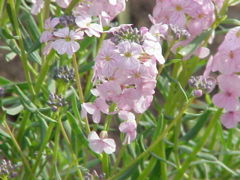Aethionema
Aethionema {{{latin_name}}}
|
Stonecress
| ||||||||||||||||||||||||||||||||||||||||
|---|---|---|---|---|---|---|---|---|---|---|---|---|---|---|---|---|---|---|---|---|---|---|---|---|---|---|---|---|---|---|---|---|---|---|---|---|---|---|---|---|---|

|
|
| |||||||||||||||||||||||||||||||||||||||
| |||||||||||||||||||||||||||||||||||||||||
| Standard Cyclopedia of Horticulture |
|---|
|
Aethionema (aitho, scorch, and nema, filament; probably referring to appearance of stamens). Cruciferae. Dwarf, shrubby herbs for the hardy herbaceous border, or rockery. Less common than Iberis. The genus differs from Iberis in having all its petals equal, and from Lepidium in having its four stamens longer, winged and toothed. Fls. various shades of pink, purple, or red, in crowded terminal racemes. W. B. Hemsley, in Gn. 9, pp. 108, 109. Aethionemas dislike moist or stiff soil or shady places; but in light, sandy loam, on dry and sunny slopes, they are compact and branchy, and when once fairly established will last for many successive years without replanting or renewal, while, under the opposite conditions, the plants grow feeble and lanky, and may die after a year or two. They keep fully as well as the candytufts in water, and can be cut with longer and straighter stems. Propagation is by seeds in spring or by cuttings in summer; annual and biennial kinds by seeds. AE. didstrophis Bunge. 10 in. high: fls. pale,rosy lilac. Mts. of Armenia.-AE persicum, Hort.Stout, erect, shrubby, dwarf: fls. deep rose.—Best of dwarfs. Intro. 1892, by J. W. Manning.
|
Cultivation
- Do you have cultivation info on this plant? Edit this section!
Propagation
- Do you have propagation info on this plant? Edit this section!
Pests and diseases
- Do you have pest and disease info on this plant? Edit this section!
Species
Select species:
- Aethionema schistosum
- Aethionema warleyense (syn. A. 'Warley Rose')
Gallery
If you have a photo of this plant, please upload it! Plus, there may be other photos available for you to add.
-
photo 1
-
photo 2
-
photo 3
References
External links
- w:Aethionema. Some of the material on this page may be from Wikipedia, under the Creative Commons license.
- Aethionema QR Code (Size 50, 100, 200, 500)
